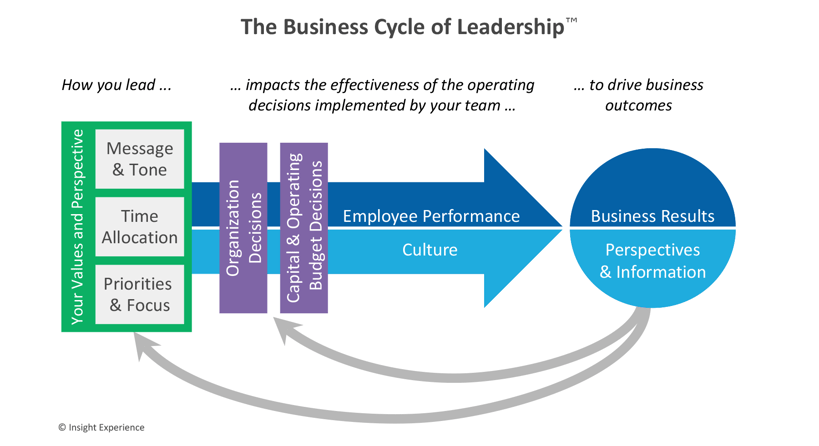Psychological safety at work is the belief that employees can express an opinion without the risk of humiliation, rejection, or punishment. As Harvard's Amy Edmondson puts it: "With so much riding on innovation, creativity, and spark, it is essential to attract and retain quality talent—but what good does this talent do if no one is able to speak their mind?" It is imperative that leaders consider concrete ways to foster environments in which employees feel safe to express their ideas without the fear of negative consequences, a notion that fits comfortably into Insight Experience's Business Cycle of Leadership™.

The Business Cycle of Leadership™ is a model that weaves two interrelated systems in which leaders work — a business system and a people system. The business system involves organizational decisions, operational decisions, a budget, and those who execute an organization's decisions to achieve business results. The people system involves the employees executing the operating decisions you make as a leader. Research shows that what you do as a leader is key to creating conditions for successful employee performance, engagement, and alignment, and three of these are a key part of the Business Cycle of Leadership™:
-
Message & Tone (what you say and how you say it).
-
Time Allocation (how you spend your time in the business and how you ask others to spend theirs).
-
Priorities & Focus (the priorities you set for the business, for others, and for yourself).
Organizations that successfully align these three elements are ones with high trust and transparency, and it's easy to see how the notion of psychological safety fits in. Leaders who nurture a positive and productive work environment in which they trust their employees to speak up, share ideas, express themselves, and even take risks — and ensure their safety in doing so — end up with happy, productive employees.

Psychological safety is an ongoing effort that requires reinforcement and a commitment to creating a supportive environment where employees thrive, reach their full potential, and are more likely to collaborate. It involves trust, respect, teamwork, engagement, learning, and growth. In addition to ensuring that clear and accessible policies and procedures exist that address conflicts promptly — everything from bullying, discrimination, and harassment to things like interpersonal conflicts, creative differences, and different styles of working — leaders can consider the following ideas for establishing an atmosphere in which employees feel secure:
-
Lead by example with emotional intelligence and self-awareness. Model the behaviors you want to see in your team by engaging in active listening and demonstrating empathy and respect to your employees. One day last fall, my family and I dropped off our oldest daughter for her first year at college more than a thousand miles away, and it was a hard goodbye for everyone involved. The next day, I was on a virtual call with Insight Experience's General Manager and feeling my daughter's absence in especially tender ways. My manager asked me how the trip went and, despite my best efforts to play it cool, I choked up and started crying. I was met with no awkwardness or discomfort. There was no red face on her part, no struggle to know what to say to me, or no abrupt shift in topic. Instead, she responded with empathy: "I understand," she said, and added: "We have to be humans at work too."
-
Establish and encourage a culture of honest communication. On a recent company call, our leaders asked us to consider ways in which we could support one another during a time of substantial growth. Many people had been feeling stretched thin. Instead of leaving this unnoticed, our leaders created a channel of communication for us to raise any concerns: We were invited to break into small groups on a virtual call and discuss (with regards to people, processes, technology, and "the kitchen sink") any risks we felt exposed to and, going forward, how we thought we could "shine."
-
Celebrate both successes and failures. Celebrating success is effortless, but failures can be met with party favors and champagne glasses too. To err is human, after all. Create an environment in which mistakes are seen as learning opportunities and celebrate them in that way. Avoid blame. Encourage a growth mindset, and don't dwell on problems. Promote learning and professional growth. In 2021, when an intern at HBO Max inadvertently distributed an empty email to subscribers with the subject line "Integration Test Email #1," the anonymous intern momentarily became a social media star: Hundreds of tweets in support of the intern appeared, people even sharing their own stories of mistakes from early in their careers. (Here you can read some of those entertaining stories.)
-
Foster collaboration, cross-functional teamwork, and inclusivity. Promote a shared sense of purpose and emphasize the value of diverse perspectives. Encourage an atmosphere of cooperation. Respect and value diversity. Ensure everyone's opinions are valued, regardless of their experience, background, or job title. One of our senior leaders and a founding partner of Insight Experience will often tell new employees: You have a fresh perspective. It is probably the most valuable one in this room full of tenured employees. There is a lot of power in reframing the "rookie" point of view as an asset — and not something that needs to be overcome.
-
Clearly and transparently communicate goals and establish clear expectations. In many of our virtual programs, I have seen our facilitators set ground rules for the training in ways that help everyone feel worry-free. One of these "Rules of Engagement" notes: "We are all in this together. Sometimes things might be messy. No need to apologize." Our facilitators want participants to know, for instance, that if their children start talking in the background or their dog starts barking, there's no need to feel embarrassed about it. These kinds of reminders immediately establish an atmosphere of inclusivity and ease.
By exercising these behaviors and building a sense of psychological safety in your team or organization, you will foster an environment that people want to be part of and one of constant innovation. The more people feel valued, appreciated, and understood as humans, the more they given themselves permission to bring their full, authentic selves to work.

Julie Danielson
Julie Danielson is a Senior Associate Consultant at Insight Experience, an award-winning global leadership development company with an expertise in business simulations. She is involved in development projects and client design spanning multiple learning experiences. Julie is also a member of the marketing team. You can often find her copyediting, creating content, and researching publishing opportunities.









